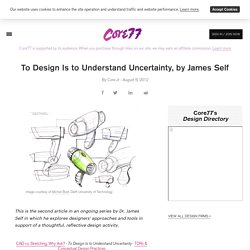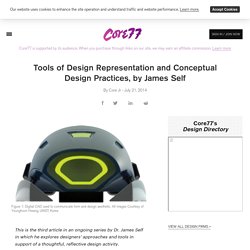

To Design Is to Understand Uncertainty, by James Self. Image courtesy of Michel Boot, Delft University of Technology This is the second article in an ongoing series by Dr.

James Self in which he explores designers' approaches and tools in support of a thoughtful, reflective design activity. Design practitioners are well-aware of and indeed exploit uncertainty as a means to facilitate design thinking, innovation and creativity. As design intentions are explored through the use of designerly tools such as sketching, design activity remains divergent, iterative and uncommitted. CAD versus Sketching, Why Ask? by James Self. This is the first article in an ongoing series by Dr.

James Self in which he explores designers' approaches and tools in support of a thoughtful, reflective design activity. A continuing issue in industrial design education is when to allow students to move from sketch work to 3D CAD modelling during studio practice—or whether to let them use CAD at all! I've heard of first year undergraduate modules where students are 'banned' from the use of CAD in an attempt to encourage sketchbook work and more explorative conceptual design practice. In my view this approach is somewhat draconian and does little to deal with the underlying reasons that attract less experienced designers to the comparative certainty of 3D CAD.
Tools of Design Representation and Conceptual Design Practices, by James Self. Figure 1: Digital CAD used to communicate form and design aesthetic.

All images Courtesy of Younghoon Hwang, UNIST, Korea This is the third article in an ongoing series by Dr. James Self in which he explores designers' approaches and tools in support of a thoughtful, reflective design activity. From thumbnail sketches to low fidelity models and prototypes to test rigs, CAD concept renderings, illustrations, mock-ups and visualizations, designers embody their design intentions using a variety of Tools of Design Representation (TDRs) during conceptual design in an attempt to provide creative solutions to often ill-defined design problems. The industrial designer employs TDRs with two objectives in mind. In light of the dizzying array of digital, conventional and hybrid tools now available to the designer, this article builds on some of the issues previously touched upon.
How to Combine PowerPoint Presentations. It’s difficult for two or more people to work on a PowerPoint presentation simultaneously, as Office doesn’t have the same collaboration features offered by Google Slides.

One way around this problem is to combine PowerPoint presentations into a single file. Merging two PowerPoints can be done by either importing the slides using the “Reuse Slides” option or by using the copy-and-paste method instead. These instructions are designed to work for the latest versions of Office, including Office 2016 and 2019, as well as Office 365 and Online. You may find the instructions vary for older versions of PowerPoint. RELATED: What's the Latest Version of Microsoft Office?
Combining PowerPoint Files Using the Reuse Slides Option The “best” method for merging PowerPoint files, or at least the method that PowerPoint officially supports, is to use the “Reuse Slides” option. To do this, open your PowerPoint presentation file—this is the file you’re looking to merge into. A menu will appear on the right. The cheap pen that changed writing forever - BBC Future. Easy way to make a custom gradient in GIMP. Collections: Where Does My Main Battery Go? – A Collection of Unmitigated Ped... This week, we’re going to have a bit of fun.

We’re going to take a look at a science fiction ship design – the eponymous Battlestar Galactica – through the lens of some ship design principles developed for early dreadnoughts. We’re going to be talking about gun position. We want to start by actually identifying the main battery on the Galactica (and others of it’s class, the Jupiter-Class in the lore of the series) and noting the gun positions. This is actually quite difficult in the show – the shaky cam and use of close-ups often makes it hard to know exactly what part of the ship you are looking at when any of the batteries fire. Fortunately, the (apparently canon, from what I can tell) strategy game Battlestar Galactica: Deadlock provides us with not one but two models of the Galactica’s class (one pre-refit, one post-refit; the latter corresponds to the version seen in the show) from its period of active service, which let us see exactly where the batteries are.
Problems Conclusion.